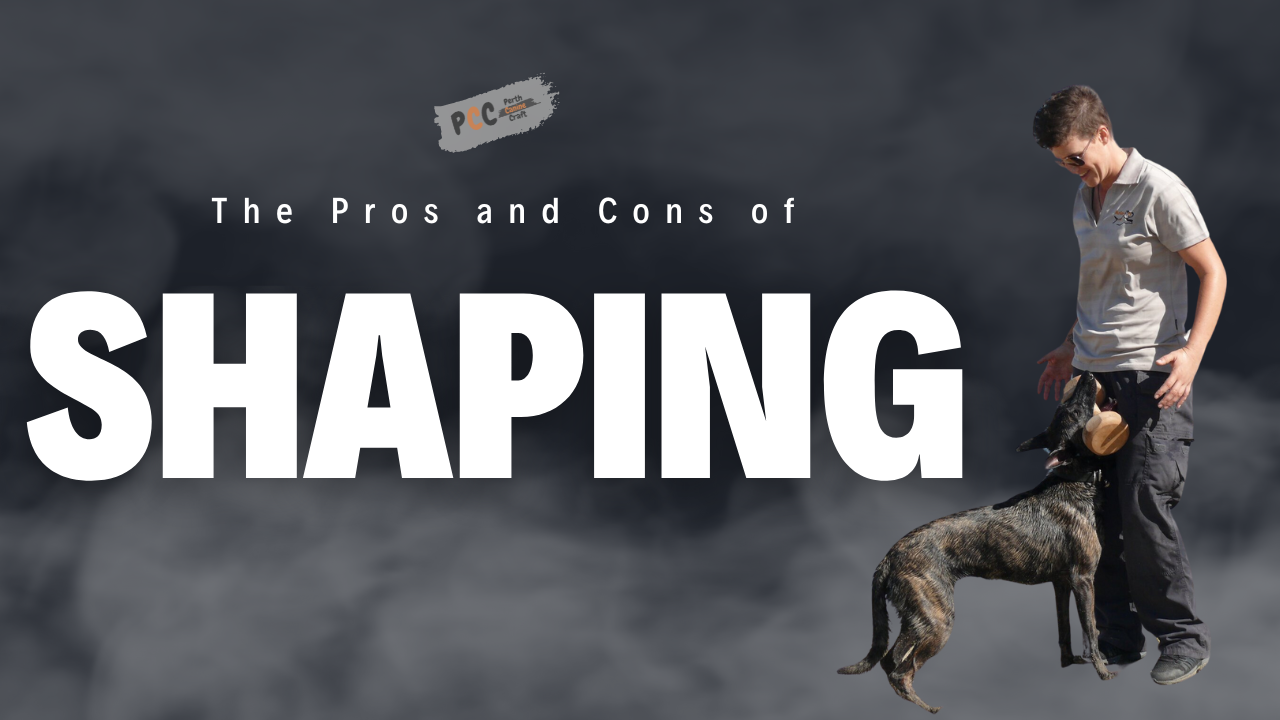Shaping, the process of moulding desired behaviours through positive reinforcement (pay) of incremental steps, is a cornerstone of modern dog training. Its effectiveness in teaching complex behaviours and fostering communication between dogs and their owners is widely acknowledged. However, like any training method, shaping comes with its own set of challenges and limitations. Let’s delve into the pros and cons of shaping in dog training:
Pros of Shaping:
- Precision Training: Shaping allows for precise training by breaking down behaviours into manageable steps. This approach promotes clearer communication between the trainer and the dog, leading to reliable learning because the dog thinks it is his/her idea.
- Encourages Problem-Solving: Dogs engaged in shaping sessions learn to think critically and problem-solve as they explore different behaviours to earn rewards. This mental stimulation is enriching and enhances the dog’s overall cognitive abilities.
- Promotes Creating Behaviour: Shaping relies on positive reinforcement to motivate and reward desired behaviours.
Cons of Shaping:
- Time-Consuming: Shaping can be a time-intensive process, requiring patience and consistency from both the trainer and the dog. Achieving complex behaviours through shaping may take longer compared to other training methods, which can be challenging for trainers with limited time.
- Skill and Observation Required: Effective shaping demands keen observation and timing skills from the trainer. Recognizing and reinforcing incremental steps towards the desired behaviour requires practice, making it challenging for novice trainers to master.
- Potential for Frustration: Both dogs and trainers may experience frustration during shaping sessions, particularly if progress is slow or if communication is unclear. Dogs may become confused or lose interest, while trainers may feel discouraged if their efforts do not yield immediate results.
- Risk of Miscommunication: Without clear communication and timing, shaping can lead to misinterpretation of desired behaviours. Inconsistent reinforcement or accidental reinforcement of undesired behaviours may occur, hindering the training process.
- Limited Applicability: While shaping is effective for teaching many behaviours, it may not be suitable for every training scenario. Some behaviours may require a different approach, such as luring or capturing, depending on the dog’s individual learning style and the complexity of the behaviour.
- Spontaneous Offering of the behaviour you are shaping: The thing is that your dog can randomly offer and do the behaviour even outside of training.
- Spontaneous Offering of Behavior: One challenge with shaping is that dogs may spontaneously offer the behaviour being shaped, even outside of formal training sessions. While this might seem like a positive sign of learning, it can pose difficulties if the behaviour is not yet fully formed or if it occurs at inappropriate times. Additionally, if the trainer fails to reinforce the behaviour consistently outside of training sessions, it may never become reliable when needed. This inconsistency can lead to confusion and frustration for both the dog and the trainer, potentially hindering progress in training.
- Challenging to Teach Command and Become Reliable: Shaping can sometimes make it challenging for dogs to understand the specific command associated with the behaviour being shaped. Since the behaviour evolves gradually through successive approximations, dogs may not readily associate a verbal cue with the action. This can result in inconsistency in responding to commands and difficulty in achieving reliability in real-world situations. Trainers may need to invest additional time and effort in explicitly teaching and reinforcing the command associated with the shaped behaviour to ensure reliability and consistency.
Shaping is a powerful tool in the dog trainer’s arsenal, offering numerous benefits for teaching complex behaviours and enhancing the bond between dogs and their owners. However, it is essential to acknowledge the potential downsides and challenges associated with shaping. With patience, practice, and skill development, trainers can overcome these obstacles and harness the full potential of shaping in their training sessions.
Remember, every dog is unique, and finding the right training approach that suits their individual needs is key to success. Whether you choose shaping or another method, consistency, patience, and positive reinforcement are the pillars of effective dog training





0 Comments